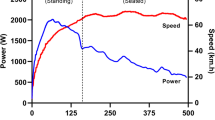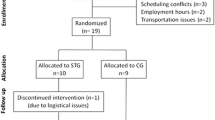Summary
Today, it is generally accepted that sprint performance, like endurance performance, can improve considerably with training. Strength training, especially, plays a key role in this process. Sprint performance will be viewed multidimensionally as an initial acceleration phase (0 to 10m), a phase of maximum running speed (36 to 100m) and a transition phase in between. Immediately following the start action, the powerful extensions of the hip, knee and ankle joints are the main accelerators of body mass. However, the hamstrings, the m. adductor magnus and the m. gluteus maximus are considered to make the most important contribution in producing the highest levels of speed. Different training methods are proposed to improve the power output of these muscles. Some of them aim for hypertrophy and others for specific adaptations of the nervous system. This includes general (hypertrophy and neuronal activation), velocity specific (speed-strength) and movement specific (sprint associated exercises) strength training. In developing training strategies, the coach has to keep in mind that strength, power and speed are inherently related to one another, because they are all the output of the same functional systems. As heavy resistance training results in a fibre type IIb into fibre type IIa conversion, the coach has to aim for an optimal balance between sprint specific and nonspecific training components. To achieve this they must take into consideration the specific strength training demands of each individual, based on performance capacity in each specific phase of the sprint.
Similar content being viewed by others
References
Larsson L, Grimby C, Karlsson J. Muscle strength and speed of movement in relation to age and muscle morphology. J Appl Physiol 1979; 46(3): 451–6
Jones DA, Round JM. Skeletal muscle in health and disease. Manchester: University Press, 1990: 98–114
Rutherford OM, Jones DA. The role of learning and coordination in strength training. Eur J Appl Physiol 1986; 55: 100–5
van Ingen Schenau GJ, de Koning JJ, de Groot G. Optimisation of sprinting performance in running, cycling and speed skating. Sports Med 1994; 14(4): 259–75
Murase Y, Hoshikawa T, Yasuda N, et al. Analysis of the changes in progressive speed during 100m dash. In: Komi PV, editor. Biomechanics V-B. Baltimore: University Park Press, 1976: 200–7
Brüggeman G-P, Glad B. Scientific research project at the games of the XXIVth Olympiad, Seoul 1988. Rome: Danesi, 1990
Fuchs P, Lames M. Mathematische Modellierung des Wettkampfverhaltens im Sprint. Leistungssport 1990; 19(5): 35–41
Delecluse CH, Van Coppenolle H, Willems E, et al. Analysis of 100 meter sprint performance as a multidimensional skill. J Hum Move Stud 1995; 28: 87–101
Jacobs R, van Ingen Schenau GJ. Intermuscular coordination in a sprint push-off. J Biomech 1992; 25(9): 953–65
Wiemann K, Tidow G. Relative activity of hip and knee extensors in sprinting: implications for training. New Stud Athletics 1995; 10(1): 29–49
Jönhagen S, Ericson MO, Németh G, et al. Amplitude and timing of electromyographic activity during sprinting. Scand J Med Sci Sports 1996; 6: 15–21
Mero A, Komi PV, Gregor RJ. Biomechanics of sprint running: a review. Sports Med 1992; 13(6): 376–92
Farrar M, Thorland W. Relationship between isokinetic strength and sprint times in college-age men. J Sports Med 1987; 27: 368–72
Alexander MJL. The relationship between muscle strength and sprint kinematics in elite sprinters. Can J Sport Sci 1989; 14(3): 148–57
Anderson MA, Gieck JH, Perrin D, et al. The relationship among isometric, isotonic and isokinetic concentric and eccentric quadriceps and hamstring force and three components of athletic performance. J Orthop Sport Phys Ther 1991; 14(3): 114–20
Sleivert GG, Backus RD, Wenger HA. The influence of a strength-sprint training sequence on multi-joint power output. Med Sci Sports Exerc 1995; 27(12): 1655–65
Behm DG, Sale DG. Velocity specifity of resistance training. Sports Med 1993; 15(6): 374–88
Komi PV. Training of muscle strength and power: interaction of neuromotoric, hypertrophic, and mechanical factors. Int J Sports Med 1986; 7 Suppl.: 10–5
Sale DG. Neural adaptation to strength training. In: Komi PV, editor. Strength and power in sport. London: Blackwell, 1991: 249–65
Holloway JB, Baechle TR. Strength training for female athletes: a review of selected aspects. Sports Med 1990; 9(4): 216–28
Goldspink G. Cellular and molecular aspects of adaptations in skeletal muscle. In: Komi PV, editor. Strength and power in sport. London: Blackwell, 1991: 211–29
Allemeier CA, Fry AC, Johnson P, et al. Effects of sprint cycle training on human skeletal muscle. J Appl Physiol 1994; 77(5): 2385–90
Staron RS, Leonardi MJ, Karapondo DL, et al. Strength and skeletal muscle adaptations in heavy-resistance-trained women after detraining and retraining. J Appl Physiol 1991; 70(2): 631–40
Staron RS, Karapondo DL, Kraemer WJ, et al. Skeletal muscle adaptations during early phase of heavy-resistance training in men and women. J Appl Physiol 1994; 76(3): 1247–55
Abernethy PJ, Jürimäe J, Logan PA, et al. Acute and chronic response of skeletal muscle to resistance exercise. Sports Med 1994; 17(1): 22–38
MacDougall JD. Hypertrophy or hyperplasia. In: Komi PV, editor. Strength and power in sport. London: Blackwell, 1991: 230–8
Schmidtbleicher D. Training for power events. In: Komi PV, editor. Strength and power in sport. London: Blackwell, 1991: 381–95
Henneman E, Sonjen G, Carpenter D, et al. Functional significance of cell size in spinal motoneurons. J Neurophysiol 1965; 28: 560–80
Tidow G. Aspects of strength training in athletics. New Stud Athletics 1990; 1: 93–110
Tidow G. Muscular adaptations induced by training and detraining: a review of biopsy studies. New Stud Athletics 1995; 10(2): 47–56
Voigt M, Klausen K. Changes in muscle strength and speed of an unloaded movement after various training programmes. Eur J Appl Physiol 1990; 60: 370–6
Newton RU, Kraemer WJ, Häkkinen K, et al. Kinematics, kinetics and muscle activation during explosive upper body movements. J Appl Biomech 1996; 12: 31–43
Komi PV, Bosco C. Utilisation of stored elastic energy in men and women. Med Sci Sports Exerc 1978; 10: 261–5
Dietz V, Schmidtbleicher D, Noth J. Neuronal mechanism of human locomotion. J Neurophysiol 1979; 42: 1212–22
Mero A, Komi PV. EMG, force, and power analysis of sprint-specific strength exercises. J Appl Biomech 1994; 10: 1–13
Delecluse C, Van Coppenolle H, Willems E, et al. Influence of high-resistance and high-velocity training on sprint performance. Med Sci Sports Exerc 1995; 27(8): 1203–9
Viitasalo JT, Hirvonen J, Mero A. Trainingswirkungen des ‘Schlepptrainings’ auf die Laufschnelligkeit, die Maximalkraft- und Explosivkraft. Leistungssport 1982; 12(3): 185–9
Majdell R, Alexander MJL. The effect of overspeed training on kinematic variables in sprinting. J Human Move Stud 1991; 21: 19–39
Bosco C, Vittori C. Biomechanische Merkmale des Sprints während maximaler und supramaximaler Geschwindigkeit. Leistungssport 1987; 16(1): 41–3
Mero A, Komi PV. Electromyographic activity in sprinting at speeds ranging from submaximal to supramaximal. Med Sci Sports Exerc 1987; 19(3): 266–74
Tabatchnik B. Neue effektive Mittel für die Entwicklung der Sprintschnelligkeit. Leistungssport 1991; 20(3): 51–3
Mero A, Komi PV. Effects of supramaximal velocity on biomechanical variables in sprinting. Int J Sport Biomech 1985; 1: 240–52
Dintiman GB. Effects of various training programs on running speed. Res Q Exerc Sport 1964; 35(4): 456–63
Fry AC, Kraemer WJ, Weseman CA, et al. The effect of an off-season strength and conditioning program on starters and non-starters in womens’s collegiate volleyball. J Appl Sport Sci Res 1991; 5: 174–81
Wilson GJ, Newton RU, Murphy AJ, et al. The optimal training load for the development of dynamic athletic performance. Med Sci Sports Exerc 1993; 25(11): 1279–86
Smith MJ, Melton P. Isokinetic versus isotonic variable resistance training. Am J Sports Med 1981; 9(4): 275–9
Häkkinen K, Komi PV. Effect of explosive type strength training on electromyographic and force production characteristics of leg extensor muscles during concentric and various stretch-shortening cycle exercises. Scand J Sports Sci 1985; 7(2): 65–76
Tihanyi J. Controlling strength and power training. In: Szécsény J, Keresztesi K, editors. European Athletics Coaches’ Conference. Budapest: European Athletic Association, 1995: 9–22
Author information
Authors and Affiliations
Corresponding author
Rights and permissions
About this article
Cite this article
Delecluse, C. Influence of Strength Training on Sprint Running Performance. Sports Med 24, 147–156 (1997). https://doi.org/10.2165/00007256-199724030-00001
Published:
Issue Date:
DOI: https://doi.org/10.2165/00007256-199724030-00001




